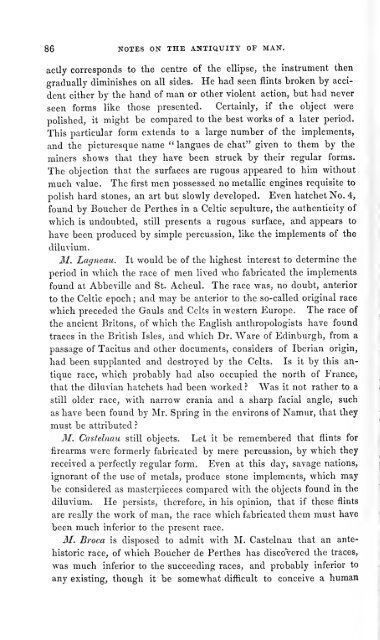The anthropological review - National Library of Scotland
The anthropological review - National Library of Scotland
The anthropological review - National Library of Scotland
You also want an ePaper? Increase the reach of your titles
YUMPU automatically turns print PDFs into web optimized ePapers that Google loves.
86 NOTES ON THE ANTIQUITY OF MAN.<br />
actly corresponds to the centre <strong>of</strong> the ellipse, the instrument then<br />
gradually diminishes on all sides. He had seen flints broken by acci-<br />
dent either by the hand <strong>of</strong> man or other violent action, but had never<br />
seen forms like those presented. Certainly, if the object were<br />
polished, it might be compared to the best works <strong>of</strong> a later period.<br />
This particular form extends to a large number <strong>of</strong> the implements,<br />
and the picturesque name " langues de chat" given to them by the<br />
miners shows that they have been struck by their regular forms.<br />
<strong>The</strong> objection that the surfaces are rugous appeared to him without<br />
much value. <strong>The</strong> first men possessed no metallic engines requisite to<br />
polish hard stones, an art but slowly developed. Even hatchet No. 4,<br />
found by Boucher de Perthes in a Celtic sepulture, the authenticity <strong>of</strong><br />
which is undoubted, still presents a rugous surface, and appears to<br />
have been produced by simple percussion, like the implements <strong>of</strong> the<br />
diluvium.<br />
M. Lagneau. It would be <strong>of</strong> the highest interest to determine the<br />
period in which the race <strong>of</strong> men lived who fabricated the implements<br />
found at Abbeville and St. Acheul. <strong>The</strong> race was, no doubt, anterior<br />
to the Celtic epoch ; and may be anterior to the so-called original race<br />
which preceded the Gauls and Celts in western Europe. <strong>The</strong> race <strong>of</strong><br />
the ancient Britons, <strong>of</strong> which the English anthropologists have found<br />
traces in the British Isles, and which Dr. Ware <strong>of</strong> Edinburgh, from a<br />
passage <strong>of</strong> Tacitus and other documents, considers <strong>of</strong> Iberian origin,<br />
had been supplanted and destroyed by the Celts. Is it by this an-<br />
tique race, which probably had also occupied the north <strong>of</strong> France,<br />
that the diluvian hatchets had been worked ? Was it not rather to a<br />
still older race, with narrow crania and a sharp facial angle, such<br />
as have been found by Mr. Spring in the environs <strong>of</strong> Namur, that they<br />
must be attributed ?<br />
M. Castelnau still objects. Let it be remembered that flints for<br />
firearms were formerly fabricated by mere percussion, by which they<br />
received a perfectly regular form. Even at this day, savage nations,<br />
ignorant <strong>of</strong> the use <strong>of</strong> metals, produce stone implements, which may<br />
be considered as masterpieces compared with the objects found in the<br />
diluvium. He persists, therefore, in his opinion, that if these flints<br />
are really the work <strong>of</strong> man, the race which fabricated them must have<br />
been much inferior to the present race.<br />
M. Broca is disposed to admit with M. Castelnau that an ante-<br />
historic race, <strong>of</strong> which Boucher de Perthes has discovered the traces,<br />
was much inferior to the succeeding races, and probably inferior to<br />
any existing, though it be somewhat difiicult to conceive a human

















